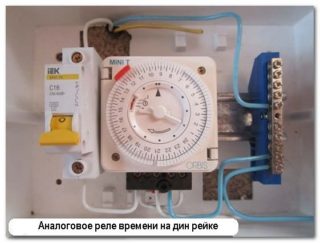A time relay is an electrical device designed to turn on and off devices with a time delay. Equipment of this class is widely used in industrial installations, providing optimal operation and control without human assistance. In addition, the time relay is often used in everyday life: when watering in the country, for example, or to turn off the lighting in time.
Types and classification
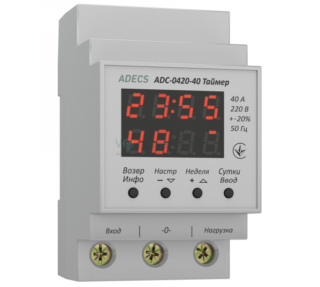
According to the method of installation, the known images of time relays are divided into the following types:
- block type devices;
- switches built into an electronic circuit;
- modular devices.
Samples of the first type are installed directly in the switched circuits, and their power buses are connected directly to phase and zero. Sometimes a junction box is used for this.
Built-in relays do not need a separate power supply as they are part of more complex electronic circuits.
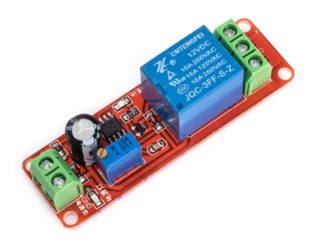
Modular devices are mounted on a DIN rail in a switch cabinet and connected to the zero and phase buses brought out here.
By the principle of their action, time relays have the following versions:
- electromagnetic type;
- pneumatic and mechanical devices;
- electronic relays.
In everyday life, electronic and electromagnetic devices are most often used, which is explained by their efficiency and availability.
Advantages and disadvantages of the device
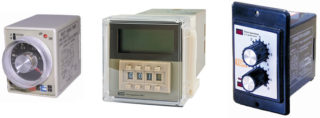
The advantages of electronic products are manifested in their high reliability and functionality. The disadvantages include the limited intervals for which the relay can be configured during programming, as well as the high cost in comparison with electromagnetic samples.
The main advantages of electric devices are:
- relatively low cost in combination with a wide range of settings - the ability to set daily intervals;
- simplicity of design in comparison with electronic models;
- no need to program and correct the settings of the time relay to turn on the light or power equipment.
The disadvantages of these devices include a limited service life, as well as some difficulties with installation and use in DC circuits.
Device and principle of operation
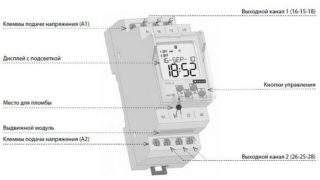
The principle of operation of a classic time relay is easiest to understand after familiarizing yourself with its device. Any such product contains the following mandatory components:
- module for setting the response time (timer);
- a setting organ displayed on the front panel;
- an actuator that is triggered after a specified time.
The principle of operation can be represented as a sequence of simple operations:
- As soon as the relay is programmed for a certain period of time, its internal mechanism begins to work in the countdown mode.
- After the specified interval has elapsed, the executive unit turns on or off the lighting network - it supplies or removes power from it.
If a relay is used to control the operation of an electric motor, its operation is based on the same principle. The only actuators are not its own contacts, but powerful contactors of the magnetic starter.
How to read the label
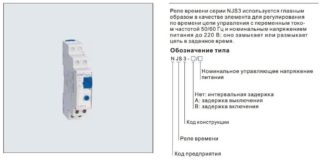
When choosing a marking code, manufacturers tried to simplify its perception as much as possible. Only the most necessary data are indicated on the relay housing:
- manufacturing firm;
- device model;
- rated voltage (usually 220 volts).
When marking, the type of current that a given brand of device operates on is sometimes indicated: direct or alternating.
The case may indicate the maximum permissible current load. Most samples of the time relay also have a marking on the input and output contacts with separate designations for "zero" and "phase". Among the well-known manufacturers of these products, the Russian companies "Meander", as well as "Relay-Avtomatika" and "Novatek-Electro" stand out.
Time relay connection diagrams
Another scheme is used when it is necessary to control significant current loads. In this case, the time relay controls the contactor of the starter included in the three-phase power supply circuit of the asynchronous motor, for example. Other options for installing and turning on the device are also possible, depending on the specific operating conditions.
Step-by-step installation instructions
- By means of the input automaton, the power grid is de-energized, into which it is planned to connect the time relay.
- The product is fixed on a DIN rail in the cabinet next to the electricity meter.
- The relay housing contains input and output contacts, marked according to the generally accepted markings.
- The phase and zero coming from the meter are connected to the input terminals, and the conductors extending towards the RCD or the machine are connected to the output terminals.
Experts advise to test its operability even before the power outage and installation of the device in the cabinet. To do this, you need to connect a regular cord with a plug to the input terminals and plug it into the network. Having set any period of time on the device, you should wait for the relay to operate and the voltage at the output disappears. To monitor the output state, you need a measuring device (tester or multimeter). If they are not there, an ordinary light bulb should be connected to the output and, by the disappearance of its glow, judge the operability of the relay. No special device configuration required
When connecting conductors to the terminal blocks, it is important to ensure that the bolts are properly tightened. To exclude possible problems during the operation of the device, it must be as reliable as possible.
Analogs of the device and errors during its installation
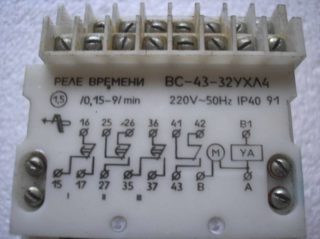
For the selection of analogs of a specific sample of the relay, a special table is used, which is given on the website of each manufacturer of the product. According to it, the model of the device ВС10-38, for example, corresponds to the sample РСВ17-3. The RKV 11-43-11 switchgear can be replaced with the RP21M-003V1 model of the same characteristics.
When choosing an electrical product and connecting it to existing power circuits, the following errors are possible:
- installation of a model that is not suitable for the given climatic conditions;
- incorrect choice of the load connected to the output terminals of the relay - an erroneous calculation of the permissible power consumption and the desire to do without power contactors;
- inattention when connecting conductors to the terminals of the device - the contacts are poorly tightened.
A careful study of models and instructions, as well as utmost care during installation, will help to avoid possible mistakes in the selection and connection of the time relay.


